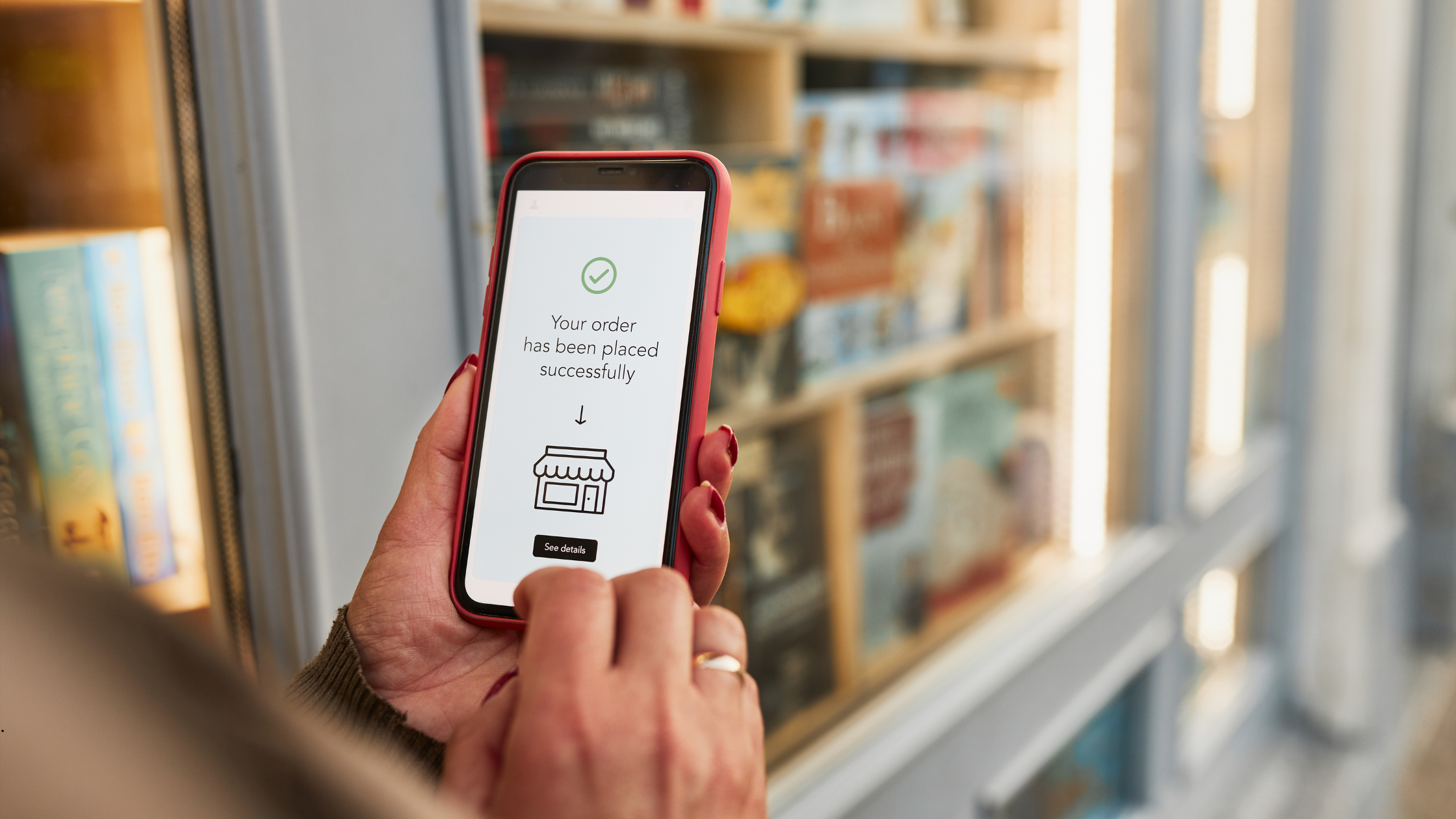
Choosing a domain name for your ecommerce store can affect everything from branding to the amount of direct traffic your site experiences. So, how can you make sure you pick one that will contribute to your success? This guide will walk you through the process of finding a registrar, registering your domain, directing the domain to your Volusion store – and choosing the perfect one for your ecommerce business.
What is a Domain Name?
First, a little background: all websites automatically reside on IP addresses, which are unique strings of numbers that identify each computer using the internet. Curious about yours? Simply Google “What’s my IP?” and you’ll be able to see the numbers that correspond to your own computer and location. Whenever you visit a website, you actually end up at its IP address; however, memorizing the IP addresses of all of your favorite websites would be quite a feat, so the domain name system (DNS) was invented. Think of the IP address as your website’s social security number, and the domain name is their given name: both are valid forms of identification, but one is a lot easier to remember.
Why are Domain Names So Important?
First and foremost, a domain name is one of your business’s first entry-points to its branding. To minimize confusion and reinforce the brand, most ecommerce shops choose to make their URL the same as their store name. Occasionally, stores may find that the URL for their shop name has already been taken or would be too long, so they’ll opt for a domain name that highlights a specific aspect of the brand. Regardless of what you choose, brand awareness should be one of your top considerations.
Additionally, owning and operating an independent URL can legitimize your business and instill trust in your prospective customers. If you’re a hobbyist, then platforms like eBay, Etsy and other ecommerce marketplaces that control your URL work perfectly fine. In fact, since the barrier to entry is extremely low on these platforms, they can be a great way to test out products and marketing strategies prior to establishing a full business identity. However, as your fledgling business grows, at some point you’ll need to “kick it out of the nest” and move it to an independent website with a unique URL. Here, your business will be able to control its own branding – from site design to marketing copy and, yes, the URL – to leave an indelible impression on your customer base.
If you’ve ever passed up a shop because it was still hosted on a subdomain like mysite.wordpress.com and opted instead for www.theothersite.com, then you understand the final component of customer trust: Many people simply don’t take ecommerce stores seriously unless they’ve tackled the basics. This includes paying for a domain, making your ecommerce site secure and thoughtfully designing your website. Your goal is to convince prospective customers that you didn’t pop up overnight and that you won’t disappear overnight, either; and something as simple as paying for a domain can signal your commitment to the long-term success of your business.
Choosing a Domain Name
Now for the fun (and difficult) part: deciding on a domain name! During this stage, your ecommerce business will likely fall into one of two categories:
1. Your business is an established brick-and-mortar or has seen success online on a subdomain or marketplace. This means it already has a name and the makings of a brand identity, and you likely want to stay as faithful as possible to that name when choosing your URL.
2. Your business is either entirely new or new enough so that you’re not tied to your name, and you’re willing to be flexible with it depending on the URL options that are available. You might not even have a name for your business yet! For many people, the URL choice dictates or inspires the company name, rather than the other way around.
Regardless of the category that you fall into, the same best practices apply as you choose your URL:
- Keep it short. Where human memory is concerned, long URLs are typically not your friend. Instead, opt for a URL that is short and easy to spell, so that users can return to your site on their first try. Because the shortest company names (and URLs) are usually in high demand, many companies opt to name themselves after words they’ve created, and their URL follows suit. Considered Pinterest, a combination of two words; Scribd or Tumblr, modified words; or Yipit, a completely new word. If you need a little help coming up with a name, check out our list of tools below.
- Do Your Research. Take care of the basics first: Make sure your domain name isn’t trademarked, protected with a copyright, or otherwise in use. Check the United States Patent and Trademark Office’s trademark search tool and the Copyright Office’s public catalog. Keep in mind that a domain’s availability does not always indicate the name’s trademark or copyright status. For example, a company may have trademarked their business name but their intended domain name was in use at the time, forcing them to use a slightly different URL. Or your domain name is in use, but the website in question is a personal blog, not a business. That’s why your best line of defense is to simply Google the name and see what comes up. If there’s another shop using the name and they are showing signs of traction and brand recognition, then you’ll want to choose a different name regardless of whether it’s trademarked or not.
- Check for Alternate Meanings. Does a word in your URL have another common meaning? This can confuse prospective customers; and depending on what your content looks like, it may even confuse the search engines. At worst, the word may have an unintentionally inappropriate slang connotation. When in doubt, just do a quick Google search for the word – or ask a teenager!
- Focus on Brandability. Do you sell parts, widgets and more? It would certainly be tempting to name yourself Parts, Widgets & More and use the corresponding URL, but think carefully about branding first. There are industries where on-the-nose names would serve you well; B2B websites, for example, can be great places for this, since the typical B2B customer cares less about brand and more about whether the site carries what they need. There are also B2C companies that have built brands out of literal business names, like American Apparel, Guitar Center and Overstock.com. However, it can sometimes be difficult to build a brand out of a literal name without a strong team of marketers.
- Consider instead using an innovative name and URL, and allow your ecommerce business to “become” that name, building the brand from the ground up. This will also afford you the flexibility to expand your product offerings later, without worrying about owning a domain name that no longer represents what you sell.
- Consider Keywords. This may seem antithetical to the advice we just gave, but the takeaway here is to consider them. Many companies, especially local ones, benefit from using keywords in their URL and company name, as they can begin ranking for their own name even if the user isn’t searching specifically for that business. For example, if someone in Austin is hungry for pizza, guess what one of the first results is for the search “austin pizza restaurants?” Yes, it’s a chain called Austin’s Pizza.
This strategy is a lot harder to implement for ecommerce stores and it often backfires; if your name is a frequently-searched keyword, you’ll be competing with so many other ecommerce shops for that keyword that you may not even be able to rank for your own name. You can partially mitigate the traffic drop by sticking with our first rule and using a short, memorable URL so repeat customers can easily remember and find your site, but relying on direct traffic alone is not a good idea. Ecommerce stores that do benefit from including keywords in their name usually sell niche, fairly low-competition products. Think about the keywords you’d use for your own shop, consider the amount of search competition and decide if the benefits outweigh any potential branding drawbacks.
- Get Feedback. It’s easy to get too close to your project, especially where URLs are concerned. Have a few friends, family members or business partners read the URL and type it into a web browser. Then ask them a couple days later to type the URL again. Did they remember it exactly? Great! If they didn’t, ask them what would have helped. It’s especially important to get extra feedback if your URL is a combination of words. www.johnsadsandmarketing.com may look like “John’s Ads and Marketing” to you, but to people unfamiliar with your business, it probably looks like John Sad Sand Marketing. Your closeness with your business might prevent you from spotting the alternative reading.
- Are any words hard to spell? Do any of your words combine to create different words – and most importantly, are those words dirty? Keep in mind that if you start your URL with a plural or possessive word, if the following word starts with a vowel, you might be creating a new word; so if your business is called Dan’s Exchange, you’ll need to think twice about your URL.
- Are there numbers or hyphens in your URL? These may seem like handy workarounds if your desired URL is taken, but your user won’t remember where to add the hyphens or whether you added a number. If your business name itself has a number in it – say, you’re called 99 Red Bassoons – you’re in the clear to use the number in your URL, because that’s how people remember your business. Incidentally, if you sell wind instruments, that one’s up for grabs.
- If your URL is your business name, are there any minor differences in words or spelling? Anything at all? Note that the URL for the Five Guys burger chain is www.fiveguys.com, not www.5guys.com. Stay faithful to distinctions like this if you have numbers in your business name. Other things that commonly trip people up: adding or subtracting “the” when you shouldn’t (ie, The Sign Outlet vs Sign Outlet); modifying a word like “to” to “2” or “extreme” to “xtreme” if it’s not modified in your business name; adding or removing plurals, or adding words like “and more” to the URL. None of these changes are things your audience will expect or remember, leading to confusion if they’re trying to find your business by typing in the straightforward URL. If your audience commonly uses one particular variation (5 Guys instead of Five Guys), it’s not a bad idea to register both domains and redirect the variant to your main URL.
- Does your business name contain special characters like ampersands or apostrophes? Congratulations, you’re exempt from that last rule! Special characters serve other purposes in URL strings – the ? denotes a query string, for example – and are not allowed in domain names. Your user will know this implicitly; if a URL did contain a special character it wouldn’t look right to them, even if they couldn’t pinpoint why. So go forth and ignore your commas, forget everything you know about apostrophes, and change that & to “and.” Is your URL extremely similar to a competitor’s URL? If the only thing separating your URL from your competitor’s is a pluralization or a “the,” rethink the URL (and your business name). It’s bad for branding, and you never want customers to end up on your competitor’s site because of a mistype.

What Not to Do
If you think you’ve found the perfect domain name, vet if for just a few more “don’ts” prior to making your decision:
What About Top Level Domains?
At the highest level of the DNS system, the Top Level Domain (TLD) resides. This is the suffix that follows the “dot,” like .net, .gov or .org. The most common TLD, of course, is .com. TLDs generally fall into one of two categories: generic or country-specific. If your ecommerce business is U.S.-based or caters primarily to U.S. customers, aim for a generic TLD. We recommend .com, the most popular; but it’s often difficult to snag a short, catchy URL with the .com suffix.
If your desired URL isn’t available as a .com, your registrar will often provide you with a few alternative TLDs, like .net, .me or .info. Additionally, in the past few years, a new “generation” of more descriptive TLDs has cropped up, including .media, .design, .solutions, and even .rocks (really), in an effort to mitigate the .com overcrowding. The industry is trending toward ever more customized domain extensions, and companies can even pay big money for a branded TLD. (For example, the URL for UK-based bank Barclays is www.home.barclays.)
It might be tempting to move with the trend and opt for a more descriptive TLD if your .com isn’t available – many successful businesses have done just that – but it is prudent to opt for .com, and your ultimate goal should be to have a unique enough URL to secure it. User behavior hasn’t quite kept up with the TLD trends, so it’s most natural for people to default to .com when they type a URL. Additionally, because spam websites have a history of using extensions like .info or .biz, an unfamiliar extension could raise unnecessary red flags for prospective customers. Remember, many people don’t even know that TLDs like .rocks exist, and may not know what to think when confronted with one! If you do decide to pioneer into descriptive TLD territory, arm yourself with a branding expert who can make your shop memorable and trustworthy.
Did Your Domain Name Pass the Test?
If you’ve avoided the “don’ts,” checked off most of the “do’s,” and your URL is available, don’t wait! Register your domain as soon as possible so it doesn’t get used for another website or purchased by a “cybersquatter” who buys domain names and sells them at higher prices. Domains are cheap, so even if you need to hold onto a URL for a couple of years, you won’t be spending much extra money.
Are You Currently Using a Domain Name That Didn’t Pass?
Don’t panic. Really. Marketing and branding can overcome even the most lackluster domain names; and conversely, a perfect URL will get you nowhere without great products, a beautiful website and a strong digital presence. Did you commit a couple “don’ts?” Plenty of popular businesses have, too. Consider Ben & Jerry’s, who dropped the “s” and opted for the counter-intuitive www.benjerry.com (which doesn’t match their Twitter handle, the more natural @benandjerrys). If you’re experiencing a “Pen Island”-level disaster (that’s an actual URL) and decide it’s time for a new domain name, take the necessary steps with redirects and any rebranding that needs to occur, and you’ll be back in business.

Helpful Domain Naming Tools
If you need a little extra help coming up with a domain name, there are plenty of tools designed to inspire you! Here are some of our favorites:
Wordoid: This free tool is absolutely stellar if you’re going to use the “modified word” naming strategy (Scribd, Tumblr). Enter the word or fragment you want to modify, and Wordoid will generate a list of creative, available possibilities. You can even customize the degree to which you want your new word to resemble the real thing! There’s a popular Austin blog called the Austinot that used Wordoid to choose their name.
Dotomator: If you’re more interested in the “word combination” strategy, Dotomator is a safe bet. Similar to Wordoid, it creates a list of new words inspired by what you feed it, but you give it two words instead of one so it can combine them. You can also combine categories or concepts if you don’t have a specific word in mind. It doesn’t filter out unavailable names the way Wordoid does, but it makes checking availability quick and easy if you like a particular domain name.
NameStation: Not interested in a made-up word? That’s okay too. NameStation operates on the same mechanism as the previous tools, but instead of creating a word out of thin air, it combines your submitted word with complimentary words based on categorized word lists. It also looks at synonyms and similar words.
Domainr: If you already have a name and a brand that you don’t want to give up, but your URL is unavailable, see what Domainr has to offer. They’ll provide you with extremely similar domain names that are available, along with alternate top-level domains.
Brandbucket: If you don’t even know where to begin when it comes to naming and branding, then let Brandbucket launch your strategy. They are a market for brand buyers and (vetted) sellers, and all you have to do is find the brand you like the best – complete with its URL, name and business logo. This isn’t cheap – average brand names run between $1,000 and $5,000, and “premium” names are tens of thousands of dollars – but it’s cheaper than hiring a brand strategist. If you just want to use it for inspiration, you can browse brands by category and take a look at what the current aesthetics are for your niche.
Registering Your Domain
Once you’ve chosen the perfect (and available) domain name, the hard part is over. You just need to register the domain name with an ICANN-accredited registrar so you can map it to your IP address. There are a number of registrars out there, and choosing one can be confusing if you don’t know the criteria you should be using. We recommend looking for the following in a registrar:
They have a business history – newer registrars aren’t always a red flag, of course, but it’s easier to trust the ones who have an established business history. Read all the reviews you can, giving leeway to a couple negative interactions but blacklisting any candidates that have consistently negative reviews, especially relative to other registrars.
There aren’t any hidden fees – read the fine print! This includes the Terms of Service. If you see the words “transfer-out fees,” back away. Some registrars will charge you two to three times the original cost of your domain registration if you want to switch to another registrar.
They give you free, easy access to the things that are rightfully yours – like your DNS settings, hostname records, and nameservers. They’ll also allow you to make Whois edits without charging you an administration fee and can mask your information for little or no cost.
They aren’t way cheaper than the competition – Bargain basement domain registrars don’t really exist, and the cheapest retail price you can expect for a .com TLD is probably around $8. If you pay for five years up front, verify post-purchase that your domain’s expiration date is in five years. Otherwise, your registrar may have only paid for a year, and they’ll charge you a fee each year when it’s time to renew. Keep in mind, this situation and other scams are not common occurrences, but if the registrar you’re looking at is far cheaper than its competition, be wary. It could belong to the too-good-to-be-true camp. At the very least, low starting prices can be a sign that you’re going to be inundated with upsell attempts.
If you’re not sure where to start, you can find a list of registrars that meet our criteria here. One that we recommend in particular is Hover. With a UX that is tailored to Volusion software and DNS settings that can automatically point to your Volusion store, Hover is an affordable, robust solution for Volusion merchants. It even provides Volusion-approved customer service (that means it’s great!).
To do your own research, Google “[registrar name] reviews,” and you should be able to sort through lists of honest feedback. Keep in mind that the more generic “registrar reviews” will likely return comparison-style blog posts from individual authors, rather than aggregate reviews. As it can be hard to determine the expertise or motives of an individual, we recommend looking at aggregates.
What About Whois Privacy?
When you register your domain, you’ll fill out information that includes your name, business address and phone number. This becomes part of ICANN’s Whois database and is publicly available by default. For webmasters who are concerned about privacy, many registrars offer free or very cheap Whois masking, which substitutes your information for their own. If your registrar doesn’t offer this, there are third-party services that do; your registrar will often point you in the direction of one they trust. If you find one on your own, perform your due diligence with research just as you did when choosing your registrar, since this is sensitive data. Note that it’s against ICANN regulations to knowingly supply incorrect contact information, but giving them your correct information and using a mask is perfectly acceptable.
We recommend masking your Whois information. This is especially true if you used a home address and phone number to register, but even if you used a PO box or your brick-and-mortar’s address and phone number, it’s still a good idea to keep it private. The chief reason for doing so, as we’re sure you’ve guessed, is spam. Many spammers go straight to the Whois records to find their next targets, and telemarketers use it to find phone numbers. There are even sham web service agencies that will call phone numbers found via Whois lookup and try to convince the webmaster that their site is performing poorly. A less common problem is a form of identity theft in which someone opens accounts or registers other web addresses using your information. The bottom line is, it’s cheap and easy to keep your information private, so save yourself from an unnecessary headache!
After You Register
Follow these tips to set up DNS hosting for your new domain and map it to your Volusion store, and you’ll be all set! Once a brand becomes well-known, many people consider purchasing alternate domain extensions or common misspellings of the brand and redirecting them. Be careful about pointing too many rogue URLs at your own; there aren’t many benefits, and if an alternate domain becomes the unintentional target of low-quality links prior to the redirect, you could pass some of the collateral damage on to your main domain. If you’re trying to protect your brand, it’s safer (and ultimately cheaper!) to just trademark it.
If you’re sure that people are commonly misspelling your name, it is appropriate to buy the misspelling and redirect it, since it makes the site accessible to lost customers. Set up a Search Console account as soon as you launch your website, and after you accrue some data, look at the search queries located in Search Traffic > Search Analytics. You should be able to notice if there’s a commonly misspelled query for your brand.
Remember to renew your domain at least annually so it doesn’t get released back into the wild, or opt for a 5- to 10-year plan. If you know you’re going to be dedicated to your business for the long haul, we recommend renewing it for at least five years to reduce your chances of letting it lapse. Then get ready to make your mark on the ecommerce landscape armed with your catchy, memorable new URL! Want to learn more? Be sure to review our recent blog post on steps to buying and setting up a domain.
Have any additional questions about domain names? Let us know in the comments!











